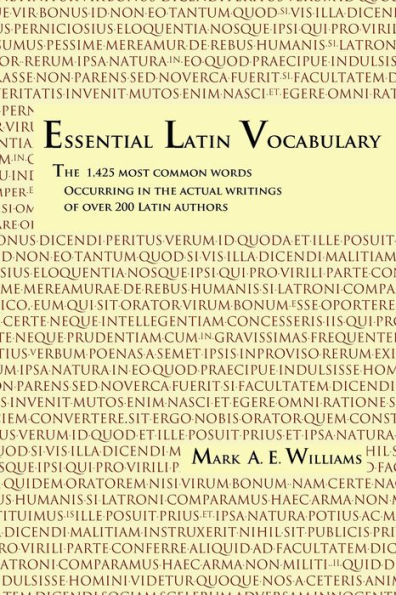This book is designed to help beginning and intermediate students master the vocabulary necessary to read real Latin with fluency and comprehension. It also serves as a resource for instructors and tutors. The text presents 1,425 words that allow a student to comprehend about 95 percent of all the vocabulary they will ever see in an actual Latin text. The terms found in the present book have been culled from statistical analyses of the works of more than two hundred authors in order to identify the core vocabulary. Were students to start out by learning the 25 most common words on this list, an astonishing 29 percent of all the vocabulary ever needed would be at their command. If a student masters the 300 most frequent words in this list, well over half of all the vocabulary necessary for fluent reading will be theirs. The goal of the book is to provide the student with the most efficient way to learn vocabulary. Chapters 1 and 2, in particular, are designed for drill, review, and study. The first chapter draws together all words that share the same grammatical classification. For example, all third declension neuter nouns are brought together in one place, with their definitions. By listing the vocabulary in grammatical groups, all the words that share a set of endings are assembled for the student: vocabulary and endings thus reinforce each other. Furthermore, each list of terms is broken down into groups of five words for ease in drawing up vocabulary lists to work with. Within the grammatical lists, each part of speech is preceded by an account of how the terms within are distributed. A student thus quickly learns that while there are 413 verbs that need to be mastered, well over one-third of these (157) are found in the third conjugation, while only about one per-cent (21) will be found in the fourth conjugation. With such information, independent students or instructors can prioritize their study and assignments more appropriately. In the second chapter, large parts of the vocabulary, with their attendant definitions, are regrouped by topics. A student who wishes, therefore, to focus on nature, human emotions, or military issues, will find such vocabulary conveniently grouped together. Chapter three lists the vocabulary terms from the most frequently occurring words to the least frequent. Students or instructors who wish to lean more heavily on the most (or least!) frequently occurring terms within their drills and studies can thus consult this frequency list. After the frequency list, the fourth chapter presents an alphabetical index of the terms. Two final chapters close the text. The first is a list of endings and paradigms for nouns, adjectives and verbs. Complete paradigms and endings are given for review. The final chapter provides the student with an additional one hundred words that are uniquely common in the Latin of the Middle Ages. These one hundred words, if added to the mix, would give the student a Mediaeval vocabulary that would match the efficiency of the Classical vocabulary that is the main focus of the book. For the effort of learning an additional one hundred words, another 1,000 years of Latin texts open up before the student. As a whole, then, this book offers the vocabulary that forms the core of one thousand seven hundred years of Latin literature. If the goal is to learn to read Latin with joy and ease, then the vocabulary terms in this book are one of the major keys to success. By learning these terms, a student's vocabulary should be ready to tackle the Latin of any era from the Classical period to the Renaissance.



